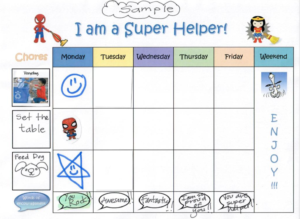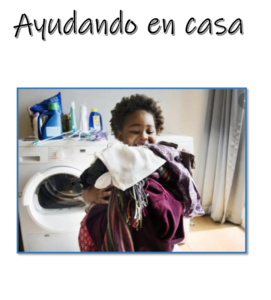
As parents we often feel that giving our child chores will be more work on our part than if we just did it ourselves. Those of us who have asked a child to clean up toys, knows that it takes twice as long to tell them, remind them, refocus them and argue with them then it does to just pick them up ourselves. Yet when we do it ourselves, we are often missing a great opportunity to teach your child the life skills of responsibility, pride, ownership and independence that they will need throughout their lifetime.
In addition, giving your child chores can actually help build Social Emotional Skills and make your child more self-aware, will build their self-esteem as they learn they can do things on their own and helps them build a sense of belonging/connectedness to the family as they see their value as a helping hand within the family unit/team.
So if chores can help build social-emotional and developmental skills as well as help you as a parent with tasks around the house, why not give it a try?

To help you get started with implementing chores for your young child at home, here are some great developmental examples of chores for kids based on age:
Chores for children ages 2 to 3
- Put toys away
- Fill pet’s food dish
- Put clothes in hamper
- Wipe up spills
- Dust
- Pile books and magazines
Chores for children ages 4 to 5
Any of the above chores, plus:
- Make their bed
- Match socks in laundry
- Empty wastebaskets
- Bring in mail or newspaper
- Clear table
- Pull weeds
- Use hand-held vacuum to pick up crumbs
- Water flowers
- Unload utensils from dishwasher
- Wash plastic dishes at sink
Chores for children ages 6 to 7
Any of the above chores, plus:
- Sort laundry
- Sweep floors
- Set and clear table
- Help make and pack lunch
- Weed and rake leaves
- Keep bedroom tidy

Once you have selected an age appropriate chore(s) for your child, start slowly by teaching your child what to do by having them watch you, then have the child do it with you several times before you let them try on their own with you providing positive reinforcement along the way. One BIG reminder: it won’t be perfect, and it won’t turn out as well as if you were to do it yourself, but that is OK! We want to encourage and support your child’s successive approximations as they learn these new skills, just like we do when they are learning things like letters and numbers.
To help track your child’s progress, here are some examples of Chore Charts in both English and Spanish you could utilize to help reinforce and praise your child for working towards their goal.
I Am A Super Helper Chart (English)
I Am A Super Helper Chart (Spanish)
We have also made a great Scripted Story you can use with your child that helps teach them how to and the importance of helping out:
Scripted Story Helping Out (English)
Scripted Story Helping Out (Spanish)
Also here is a Video Example showing a parent using some behavior strategies from CVESD’s Parent Implementation Program (PIP) to support their child doing a laundry related task:



